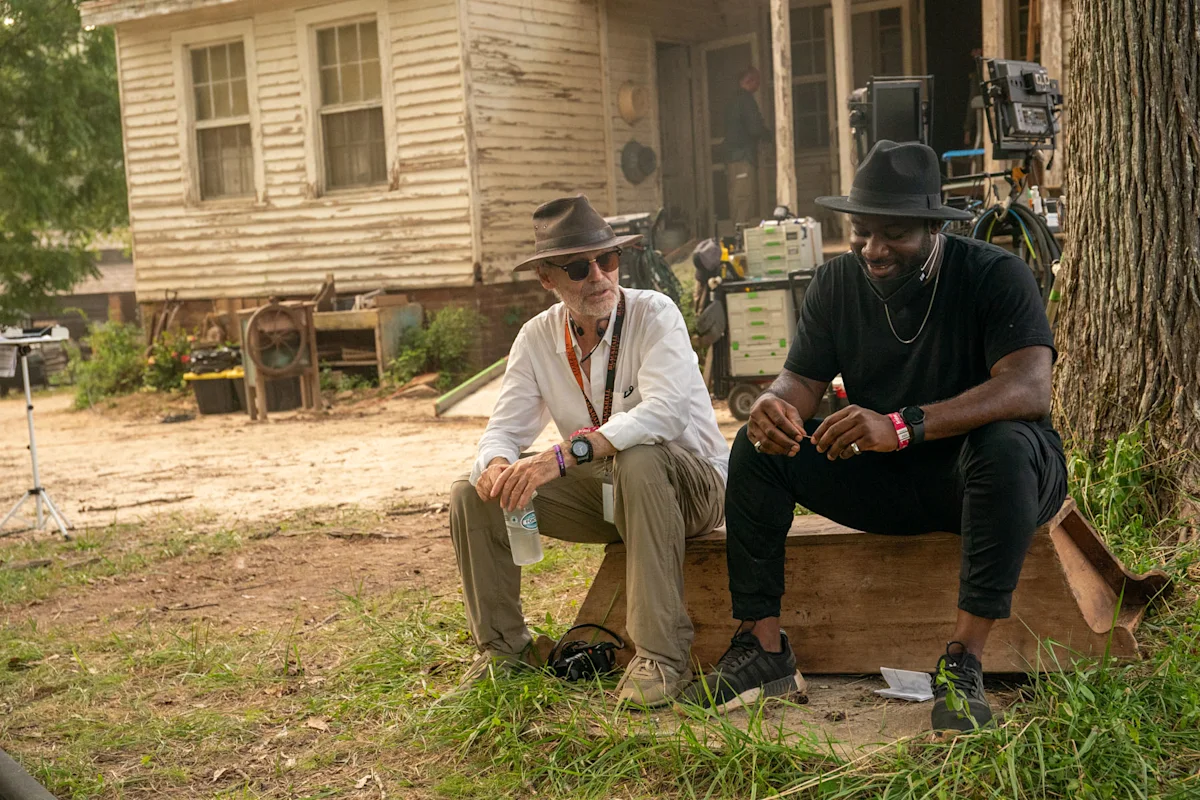Danish cinematographer Dan Laustsen is known for his collaborations with Guillermo del Toro, receiving Oscar nominations for his work on The Shape of Water (2017) and Nightmare Alley (2021), as well as for shooting three out of the four John Wick movies. As seemingly disparate as those projects may seem, they also made him the perfect person to lens director Blitz Bazawule's musical adaptation of The Color Purple.
"The camera and the actors and the dancers, it's a kind of ballet," Laustsen explains. "In John Wick, they're fighting, but they're dancing around with the camera. That's the same on The Color Purple, because the dance numbers are so powerful, and you want to be in there with them."
Laustsen's resume is as rich and textured as the images he puts on the screen. And although everything he's done in his four decades behind the camera prepared him in one way or another for The Color Purple, the director of photography had to approach the movie — with its vibrant color palette, dynamic lighting, and exacting camera movement — with fresh eyes.
"You have to be open-minded. You have to think about new ways to do it. You can't be afraid of pushing yourself," Laustsen tells A.frame. "You can't be afraid of making mistakes, because you learn from mistakes — but don't make too many!"
A.Frame: Where did you start with this project? And what were the first conversations that you had with Blitz Bazawule about his vision for the film?
The very first time we spoke was over Zoom, because it was during the pandemic. I was living in Copenhagen, and he was in Atlanta. We discussed whether I'd like to do the movie and then discussed references. I said that a movie I really love is Soy Cuba, or I Am Cuba, Mikhail Kalatozov's black-and-white movie from 1964. Blitz said, 'That's funny, because I love that movie too.' That was actually our very first conversation. It had nothing to do with The Color Purple, had nothing to do with this movie, but both of us were very inspired by that movie, because it is an amazing piece of art. The way the story is told makes you really feel like you really are in there. Later on, we had a lot of Zoom meetings about how should we tell this story, how it should look and all that kind of stuff, but the first thing we talked about was I Am Cuba.
Did you see that as a sign that you were really going to click out of the gate?
One hundred percent, because that movie is so spacial. It's also a very atmospheric and textured movie. One of the most important things when you start a project is that you're thinking the same things about storytelling. It was always going to be a wild card in the beginning, because we didn't know each other and hadn't met but we clicked and it was a pleasure.

For this iteration of The Color Purple, you have the original book, Steven Spielberg's movie, and the Broadway musical to draw from. They're all unique in their own ways. How did they each influence your vision for this new iteration?
I think the movies have their own lives. They all have this story that is very strong and the musical is beautiful, but when you have to blend those things together, you have to start from scratch. We had to go into the movie with open minds, thinking, 'What is the movie Blitz wants to do?' He had made an animatic for the movie, which he put together with the music and dialogue. That was the first thing I saw, and it was pretty cool. He spent a lot of time doing that, and it was a really nice guide, and then we took it from there. Drawings are one thing and the movie is another, but it was a very nice way to walk into the project. You have to try to go into a movie open-minded and then figure out the director's vision, because that's where everybody's going.
How did you see the role of the camera in this movie? Did that role change between the dramatic scenes and the musical numbers?
I think it was important for us to realize drama is one thing and the musical is another, but they have to blend together. It's not like when you're coming into the music world, it's a new movie. However, we wanted to be a part of the music, so we didn't want to stand out like they did in the films of the 1930s, when you see everything in a big shot. We did that as well, but we wanted to be in with the characters as much as possible. We wanted to be a part of the dance; the camera should be a ballet between the actors and the dancing. So, we had a lot of movement in the camera, and that was where the influence from I Am Cuba came in. Both Blitz and I had the same feeling right from the beginning, that the camera had to be a third partner in the dance numbers.
What did that look like on the set?
We didn't do any gimbals at all. We did cranes a lot, and then we used a lot of Steadicam. We used dollies now and then, but the A camera was on the crane a lot, and the B camera was on Steadicam, or the opposite way around. You could really be in there with the cast — especially with the Steadicams — and you didn't have a lot of equipment around you.
Was there also an element of choreography for those who were manning the cameras?
Absolutely. We had fantastic operators from Atlanta who were really good. We saw all the dance numbers in advance and talked about how the choreographer had done a fantastic job with the dancers. We saw those rehearsals and discussed the way Blitz wanted to shoot them, the way the choreographer wanted them to be seen, and the way I wanted to shoot it. The operators were in there too, so we could all figure out where the camera would be in those scenes, and of course, where we didn't want it. There's some choreography involved in knowing where not to stand because the crane arm is coming in, but they were all professional dancers and always knew what they're doing. We rehearsed that a lot.

The Color Purple has a distinctive color palette, with a mixture of very bright tones and a lot of muted, earthly tones. How did you deal with making sure that those two worked together?
The earthy colors were a base. A lot of the houses and the bar and the store, we wanted to have very strong daylight coming from outside, blowing in through the windows. We were not afraid of the darkness, and we really felt that the rooms should be dark and a little scary to be in. Because we wanted the feeling that freedom was outside the rooms, that the future was out there. In the dance numbers, we wanted to change the color palette to be a little bit more modern. They had to be more alive and vibrant, but the basics were still there. We had to find a line between the two, so that when you're coming back to the scenes inside the house, they are much more moody and depressive even though it is still a very colorful movie.
You mentioned not being afraid of the dark, and you've shot such like The Shape of Water, Crimson Peak, and several John Wick movies, all of which play with rich, dark palettes and spaces. What did you learn on those films were you able to utilize here?
You have to light the room and the actors. You can't treat them as two things. The actors have to look powerful for the scene, but at the same time, you have to keep the atmosphere in the room. I use single source lighting, very old-fashioned lights — 10K and 20K, all pointing the right direction — and we used very little LED light on those sets. We use a lot of big lights, like Dinos, that are very direct, and bounce light as well, but all the light was outside the room. We had very few lights in the room. It was more about putting the light in the right position, because that alone can make such a big difference.
What did you imagine would be most challenging sequence to shoot? And did that turn out to be the case?
The biggest technical challenge was when [Shug Avery] comes into the juke joint at night. That was a set built in a real swamp near Atlanta, and we had to build roads to bring the big crane in. I had a very clear idea about how that should be lit, but the camera's moving so much. The close-up has to be beautiful, but the master has to be atmospheric and dark. That's a challenge, because the light is coming from so far away, the camera is moving around on the Technocrane on a boat, and then you had this added element, which was smoke. The smoke looked beautiful, but it is your best friend and your worst enemy at the same time. When it works, it's amazing, but when it doesn't work, it's a nightmare. And we used a lot of smoke in that scene. We were lucky on the day we shot that scene. There was no wind, so it was floating perfectly. But it was still a big challenge to do.
You also had humidity and moisture to contend with.
Absolutely. They had to rebuild the swamp. The art department had to drain it and rebuild it, and then fill it up with water again, and it's surrounded by 200-feet high trees. Getting the big cranes in there was an issue, and then we couldn't find the right place for them. Everything is in your imagination until you get it set up. And you don't know if you're set up in the right place before the cranes go, because moving them is two days work. There was lot of planning there and crossed fingers, as well as maybe relying on a little bit of experience. I was really concerned for a while, but it turned out pretty well!
RELATED CONTENT:
'The Color Purple' Cinematographer Dan Laustsen's Top 5
Danielle Brooks Said 'Hell Yes' to 'The Color Purple' and Wound Up Healing Herself (Exclusive)







